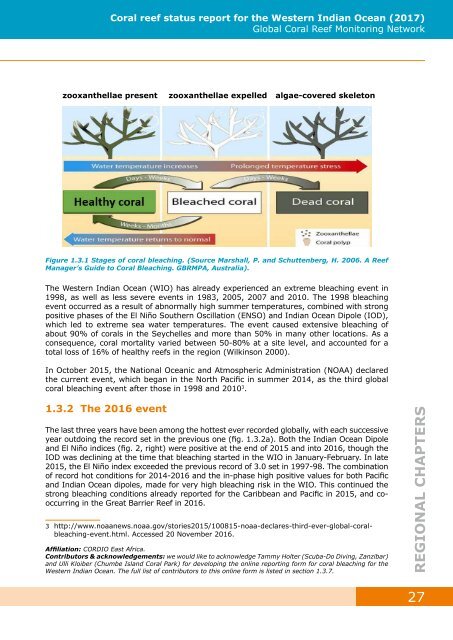GCRMN_COI_2017-Western Indian Ocean Reef Status
GCRMN Western Indian Ocean Coral Reef Status report for 2017. Produced by the Indian Ocean Commission and CORDIO East Africa
GCRMN Western Indian Ocean Coral Reef Status report for 2017. Produced by the Indian Ocean Commission and CORDIO East Africa
You also want an ePaper? Increase the reach of your titles
YUMPU automatically turns print PDFs into web optimized ePapers that Google loves.
Coral reef status report for the <strong>Western</strong> <strong>Indian</strong> <strong>Ocean</strong> (<strong>2017</strong>)<br />
Global Coral <strong>Reef</strong> Monitoring Network<br />
zooxanthellae present zooxanthellae expelled algae-covered skeleton<br />
Figure 1.3.1 Stages of coral bleaching. (Source Marshall, P. and Schuttenberg, H. 2006. A <strong>Reef</strong><br />
Manager’s Guide to Coral Bleaching. GBRMPA, Australia).<br />
The <strong>Western</strong> <strong>Indian</strong> <strong>Ocean</strong> (WIO) has already experienced an extreme bleaching event in<br />
1998, as well as less severe events in 1983, 2005, 2007 and 2010. The 1998 bleaching<br />
event occurred as a result of abnormally high summer temperatures, combined with strong<br />
positive phases of the El Niño Southern Oscillation (ENSO) and <strong>Indian</strong> <strong>Ocean</strong> Dipole (IOD),<br />
which led to extreme sea water temperatures. The event caused extensive bleaching of<br />
about 90% of corals in the Seychelles and more than 50% in many other locations. As a<br />
consequence, coral mortality varied between 50-80% at a site level, and accounted for a<br />
total loss of 16% of healthy reefs in the region (Wilkinson 2000).<br />
In October 2015, the National <strong>Ocean</strong>ic and Atmospheric Administration (NOAA) declared<br />
the current event, which began in the North Pacific in summer 2014, as the third global<br />
coral bleaching event after those in 1998 and 2010 3 .<br />
1.3.2 The 2016 event<br />
The last three years have been among the hottest ever recorded globally, with each successive<br />
year outdoing the record set in the previous one (fig. 1.3.2a). Both the <strong>Indian</strong> <strong>Ocean</strong> Dipole<br />
and El Niño indices (fig. 2, right) were positive at the end of 2015 and into 2016, though the<br />
IOD was declining at the time that bleaching started in the WIO in January-February. In late<br />
2015, the El Niño index exceeded the previous record of 3.0 set in 1997-98. The combination<br />
of record hot conditions for 2014-2016 and the in-phase high positive values for both Pacific<br />
and <strong>Indian</strong> <strong>Ocean</strong> dipoles, made for very high bleaching risk in the WIO. This continued the<br />
strong bleaching conditions already reported for the Caribbean and Pacific in 2015, and cooccurring<br />
in the Great Barrier <strong>Reef</strong> in 2016.<br />
3 http://www.noaanews.noaa.gov/stories2015/100815-noaa-declares-third-ever-global-coralbleaching-event.html.<br />
Accessed 20 November 2016.<br />
Affiliation: CORDIO East Africa.<br />
Contributors & acknowledgements: we would like to acknowledge Tammy Holter (Scuba- Do Diving, Zanzibar)<br />
and Ulli Kloiber (Chumbe Island Coral Park) for developing the online reporting form for coral bleaching for the<br />
<strong>Western</strong> <strong>Indian</strong> <strong>Ocean</strong>. The full list of contributors to this online form is listed in section 1.3.7.<br />
REGIONAL CHAPTERS<br />
27


















